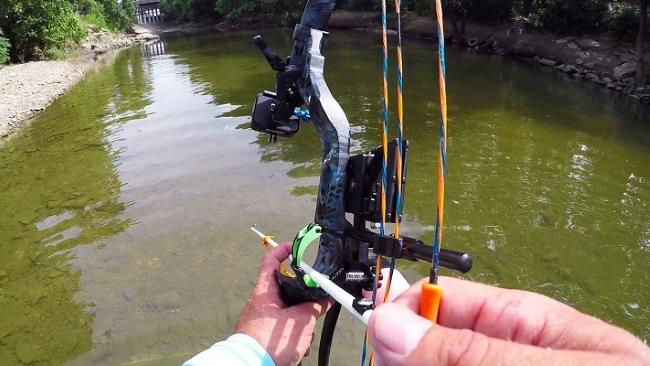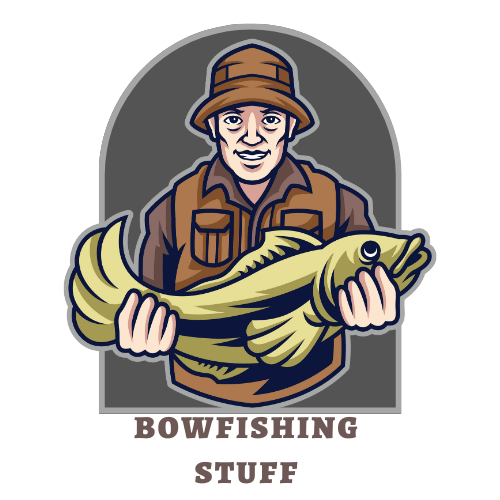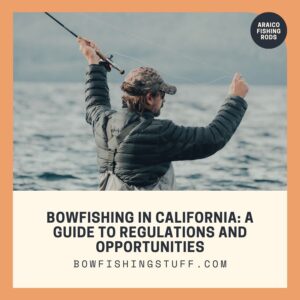Worldwide, Maryland is one of the blessed lands and it is because of the nature it presents, the beautiful landscapes, the climate, the vegetation among other elements. Perhaps, it is not one of the largest, but it has a little of everything to offer, among the blue waters of the Atlantic there are also the fluvial currents of the different rivers that make up this magical nature.
Now, bowfishing in Maryland offers fishing in a free and fun way, although it has a large number of public rivers where you can carry out such an activity, in some places you must have a license to fish.
Likewise, it has an area for all ages and levels of fishermen such as beginners, and experts or those who want to immerse themselves in a boating adventure and experience their fishing skills with their families, taking advantage of the opportunities provided by this beautiful state.

Maryland’s Bowfishing Hotspots: Exploring the Best Locations for a Successful Day
Maryland offers bowfishing enthusiasts a plethora of exciting opportunities to explore its diverse waterways and land prized catches. From the Chesapeake Bay to its scenic rivers and estuaries, Maryland is a haven for bowfishermen seeking a successful and thrilling day on the water. In this article, we will delve into the top bowfishing hotspots in Maryland, showcasing the unique characteristics of each location, the target species you can expect to encounter, and the strategies for maximizing your bowfishing success. Get ready to discover the best bowfishing spots Maryland has to offer and make your next outing an unforgettable experience.
Chesapeake Bay:
It is a spectacular blue sea of the Atlantic Ocean made up of the lower part of Virginia and the upper part of Maryland. For various reasons, fish of different species have flowed into this bay in large quantities, which has generated great pollution and has caused a reduction in fishing.
This bay is considered very important because it is part of the navigation route of the Atlantic Intercoastal Canal. And on the other hand, the dock of this bay is a charming place, especially in the afternoon hours when the sun goes down.
Also, it is wonderful to see around the pier in the morning the number of boats with fishermen. Thus, there are also cruises that offer the activity of fishing in their tour and many enjoy and even photograph themselves when they manage to catch striped bass, of which they only allow three, but it is sure to be very exciting.
Choptank:
On the Choptank River in Cambridge, Maryland, a portion of the fishing starts at the old bridge, which is used as a fishing pier. It has a nice lighthouse, the views are beautiful, and the marina staff is friendly.
Commonly known for fishing, as it hosts brown and rainbow trout, as well as smallmouth on the power plant discharge. This huge river on the border of Maryland and Pennsylvania is one of the pioneer fishing spots.
This reservoir lends itself to the habitat of fish such as walleye and smallmouth bass, and this is the primary game fish. The Youghiogheny is popular for fun and adventurous activities such as canoeing, kayaking, and white water rafting.
Likewise, three sections of the river, varying in difficulty, are predictably available for whitewater recreation.
Assateague Island
Wonderful American island located on the eastern coast of the states of Maryland and Virginia. It is known as the habitat of animals such as wild horses, beautiful virgin beaches where you can practice fishing.
Actually, it is very organized in terms of camping, you must present a permit to camp and it is only allowed in the area that belongs to Maryland, there are multiple activities that you can do in the swamps, bays, and coves.
You should be prepared with everything you need such as sunscreen, insect repellent, firewood, tents to shelter under the shade, and what is necessary to anchor the tents in the sand and the wind. And of course the fishing utensils and if you prefer hunting too.
Potomac River:
Flowing through Maryland, the Potomac River is renowned for its diverse fish population. Bowfishermen can target species such as snakehead, carp, gar, and catfish. The river’s backwaters and coves offer excellent bowfishing conditions.
Nanticoke River:
The Nanticoke River is a hidden gem for bowfishing in Maryland. This picturesque river is teeming with carp, catfish, and bowfin. Navigate its winding channels and oxbow lakes to encounter these sought-after species.
Susquehanna River:
The Susquehanna River is a popular destination for bowfishing adventures. It is known for its abundance of carp, catfish, and smallmouth bass. Bowfishermen can enjoy productive outings in the river’s shallow flats and eddies.
Pocomoke River:
The tranquil Pocomoke River offers a serene bowfishing experience. Target species include gar, bowfin, and largemouth bass. Explore its winding channels and submerged structure for prime bowfishing opportunities.
Deep Creek Lake
It is an artificial lake that is located in Garrett County near the Wisp ski resort and is considered the largest in Maryland, it is home to a diverse amount of freshwater fish, as well as waterfowl.
This fabulous lake offers activities in any season of the year, but for those who have a passion for fishing, this scenario awaits them in the spring and autumn season to get on a boat, dive into the water and live with their family a pleasant fishing Day.
Both a weekend visit and a vacation are good for fishing as well as other activities such as riding jet skis, white river rafting, hiking, among others. You just have to plan your trip and take everything you need to live a nice day of fishing that will later be part of wonderful memories.
Eastern Shore Tributaries:
Maryland’s Eastern Shore is dotted with numerous tributaries that provide excellent bowfishing opportunities. From the Wicomico River to the Choptank River, these tributaries offer a variety of species, including carp, perch, and catfish.
Coastal Bays:
Maryland’s coastal bays, such as Assawoman Bay and Isle of Wight Bay, offer a mix of freshwater and saltwater species for bowfishing enthusiasts. Target species may include flounder, redfish, sheepshead, and rays.
Maryland’s bowfishing hotspots provide a wealth of opportunities for anglers seeking thrilling and successful outings. Whether you choose to explore the Chesapeake Bay’s vast estuary, navigate the winding rivers, or venture into the coastal bays, each location offers its own unique charm and target species. By visiting these top bowfishing hotspots in Maryland, you’ll have the chance to encounter a variety of fish and create unforgettable memories while honing your bowfishing skills. Get ready to embark on your next bowfishing adventure in Maryland’s best locations for a truly successful day on the water.
Rules and Regulations: is Bowfishing Legal in Maryland?
Maryland Department of Natural Resources lists rivers, lakes, ponds, and marine waterways for bow fishing on its website. It also lists various species for bow fishing. Maryland anglers and non-resident anglers who wish to bow fish must comply with Maryland rules and regulations.
Knowing where to fish, when to fish and what species are allowed for targeting is important information for bow hunters. Proper bow rigs for fresh water and saltwater conditions can make bow fishing a rewarding endeavor.
According to the Maryland DNR, bow fishermen may not take fish with a bow and arrow unless the arrow has a barbed metal tip attached to the line. Through the process of shooting an arrow, the fishermen must be able to retrieve the fish.
In addition, fishermen may not release back into the waters any fish pierced with an arrow, whether dead or alive. Anglers may not violate local rules and regulations prohibiting the discharge of a bow and arrow within county jurisdiction.
Anglers should check for local laws regarding the use of a bow and arrow within all counties. According to the Maryland DNR, removing fish with a bow and arrow indoors, peripheral and contour routes can occur at any time of day during the open season.
Maryland allows carp and some species of freshwater catfish during bow season. In saltwater, state regulations allow fishing for rays and flounders.
Bowfishing Licenses in Maryland
In Maryland, bowfishermen are required to obtain the appropriate licenses and permits before engaging in bowfishing activities. Here is an overview of the bowfishing licenses and permits in Maryland:
- Maryland Resident Fishing License: All residents aged 16 years and older must possess a valid Maryland Resident Fishing License to bowfish in the state. This license allows residents to fish, including bowfishing, in the freshwater and tidal areas of Maryland. The license is valid for a specific duration and can be obtained through the Maryland Department of Natural Resources (DNR) website or authorized licensing agents.
- Non-Resident Fishing License: Non-residents aged 16 years and older must obtain a Non-Resident Fishing License to engage in bowfishing activities in Maryland. Similar to the resident license, this permit allows non-residents to fish, including bowfishing, in Maryland’s freshwater and tidal areas. The license can be obtained through the Maryland DNR website or authorized licensing agents.
- Chesapeake Bay and Coastal Sport Fish License: In addition to the standard fishing license, bowfishermen targeting fish species in the Chesapeake Bay and its tributaries may require a Chesapeake Bay and Coastal Sport Fish License. This license is necessary for individuals aged 16 and older and can be obtained online or through authorized licensing agents.
- Age Exemptions: Children under the age of 16 are generally exempt from requiring a fishing license in Maryland. However, it is essential to review the specific regulations and exemptions outlined by the Maryland DNR to ensure compliance.
- Special Seasons and Areas: Some areas and specific fish species may have additional regulations, including special seasons or catch limits. Bowfishermen should stay updated on any special regulations or restrictions pertaining to the areas they plan to bowfish, such as certain tidal waters or conservation areas.
It is important for bowfishermen to familiarize themselves with the current Maryland fishing regulations, license requirements, and any specific bowfishing restrictions before heading out on the water. The Maryland DNR website or local fishing authorities can provide detailed and up-to-date information on licensing and regulations to ensure compliance and a successful bowfishing experience.
A Guide to the Fish You Can Expect to Encounter while Bowfishing in Maryland”
Bowfishing in Maryland provides an exciting opportunity to target a diverse range of fish species in its abundant waterways. From freshwater rivers to the brackish waters of the Chesapeake Bay, Maryland offers bowfishermen a variety of target species to pursue. In this article, we will explore the fish you can expect to encounter while bowfishing in Maryland, providing insights into their habits, habitats, and bowfishing strategies. Whether you’re a seasoned bowfisherman or new to the sport, this guide will help you prepare for an exhilarating bowfishing experience in Maryland.
- Snakehead: The invasive northern snakehead is a prized target for bowfishermen in Maryland. Found in various water bodies, including the Potomac River and the Chesapeake Bay, snakehead is known for its aggressive behavior and hard-fighting nature. Bowfishermen often spot them in shallow areas and backwaters, making them a challenging but rewarding target.
- Carp: Carp, including common carp and grass carp, are prevalent in Maryland’s rivers, lakes, and estuaries. These species are known for their strong fight and can be found in both freshwater and brackish water environments. Carp often congregate in shallower areas, such as flats and weedy sections, presenting bowfishermen with excellent opportunities for successful shots.
- Catfish: Maryland’s waterways are home to various catfish species, including channel catfish and blue catfish. These bottom-dwelling fish can be found in rivers, creeks, and the Chesapeake Bay. Targeting catfish requires patience and accurate shots near structures, such as submerged logs and rock formations, where they seek shelter and prey.
- Gar: Longnose gar and spotted gar are commonly encountered while bowfishing in Maryland. These prehistoric-looking fish are known for their long, slender bodies and sharp-toothed jaws. Gar can be found in shallow, weedy areas and often surface to breathe. Bowfishermen must aim for accurate shots to penetrate their tough scales.
- Perch: Yellow perch and white perch are popular targets for bowfishermen in Maryland’s rivers and estuaries. These smaller-sized fish are known for their schooling behavior and can be found near structures, such as docks and submerged vegetation. Precision and quick reflexes are essential when targeting perch.
- Flounder: Bowfishermen along Maryland’s coastal bays may encounter southern flounder. These flatfish species inhabit sandy and muddy bottoms and are well-camouflaged to blend in with their surroundings. Bowfishermen should look for them in shallow areas during their active feeding times, using their ability to change colors to their advantage.
- Sheepshead: The brackish waters of Maryland’s coastal bays are home to sheepshead. These fish have distinctive black stripes and strong, grinding teeth, making them a unique and challenging target. Bowfishermen can find them near structures, such as jetties and pilings, where they feed on shellfish.
Bowfishing in Maryland offers a diverse range of target species that provide excitement and challenges for bowfishermen of all skill levels. From the invasive snakehead and hard-fighting carp to the bottom-dwelling catfish and prehistoric-looking gar, Maryland’s waters are teeming with opportunities to test your bowfishing skills. Whether you’re exploring the freshwater rivers, estuaries, or coastal bays, understanding the habits and habitats of these target species will help you make successful shots. Prepare yourself for an unforgettable bowfishing adventure as you encounter and target these fascinating fish species while bowfishing in Maryland.
Essential Gear for a Day of Bowfishing in Maryland’s Waters
Gear plays a crucial role in ensuring a successful and enjoyable day of bowfishing in Maryland’s waters. Here are some essential items you’ll need to have for a productive bowfishing outing:
Bowfishing Bow:
Invest in a specialized bowfishing bow designed to withstand the rigors of the sport. These bows are typically more durable and have features like heavy-duty reels and solid construction to handle the challenges of bowfishing.
Bowfishing Reel:
Choose a bowfishing-specific reel that can handle the strain of reeling in fish. Options include retriever reels or spin-cast reels with strong line capacities. Ensure the reel is compatible with your bow and offers smooth line retrieval.
Bowfishing Arrows:
Opt for bowfishing arrows designed for this purpose. These arrows are typically heavier and equipped with barbed points or specialized tips to ensure secure fish retrieval. Look for durable materials that can withstand underwater conditions.
Bowfishing Line:
Use strong and durable bowfishing line that can withstand the tension of battling fish. Braided nylon or spectra line is commonly used, offering high strength and low stretch for improved accuracy and retrieval.
Bowfishing Rest:
Consider a bowfishing-specific arrow rest designed to securely hold your arrow in place during shots. Roller rests or capture-style rests are popular choices, providing stability and smooth arrow release.
Polarized Sunglasses:
Invest in a pair of polarized sunglasses to enhance visibility and reduce glare on the water’s surface. These sunglasses help you spot fish and navigate potential obstacles more effectively.
Headlamp or Bow-Mounted Light:
If you plan to bowfish during low-light conditions or at night, a headlamp or bow-mounted light is essential. It illuminates your target area, allowing for better visibility and accurate shots.
Waders or Waterproof Boots:
Depending on your bowfishing location, waterproof waders or boots are crucial to keep you dry and comfortable. They protect against water infiltration and provide traction on slippery surfaces.
Fish Grips or Gloves:
To handle and secure fish safely, consider using fish grips or gloves. These tools allow for a secure grip on the fish while protecting your hands from sharp fins and teeth.
Cooler or Fish Bag:
Keep your harvested fish fresh by bringing a cooler or fish bag with ice. This ensures that the fish remains in optimal condition until you’re ready to clean and prepare them.
Remember to check and comply with Maryland’s specific regulations regarding gear and equipment requirements for bowfishing. It’s important to prioritize safety, adhere to all fishing regulations, and respect the environment while enjoying your bowfishing adventures in Maryland’s waters.
Tips and Techniques: Mastering the Art of Bowfishing in Maryland’s Unique Conditions
Mastering the art of bowfishing in Maryland’s unique conditions requires a combination of skill, knowledge, and adaptability. Here are some tips and techniques to enhance your success and enjoyment while bowfishing in Maryland’s waters:
- Know the Regulations: Familiarize yourself with Maryland’s fishing regulations, including specific bowfishing regulations, seasons, bag limits, and areas where bowfishing is permitted. Stay updated on any changes to ensure compliance and to protect the state’s fish populations.
- Scout Potential Locations: Before your bowfishing trip, research and scout potential bowfishing locations in Maryland. Look for shallow areas, backwaters, submerged vegetation, and structures such as docks or fallen trees, as these are often prime spots for fish to congregate.
- Timing is Key: Plan your bowfishing outings during periods when fish are most active, such as early morning or late evening. Some species, like catfish and carp, are more active at night. Adapt your fishing times accordingly to maximize your chances of encountering target species.
- Polarized Sunglasses: Wear polarized sunglasses to improve visibility in the water, reduce glare, and help you spot fish more easily. The enhanced vision allows for better targeting and accurate shots.
- Stealth and Silence: Approach your bowfishing locations quietly and with minimal disturbance. Fish can be easily spooked by noise or sudden movements, so maintaining a low profile and moving stealthily will increase your chances of getting closer to your targets.
- Practice Shot Placement: Aim for the area just behind the fish’s gill plates or slightly below the lateral line. This ensures a clean and effective shot. Practice your aim and focus on making accurate shots to increase your success rate.
- Adjust for Refraction: When aiming at fish underwater, account for the refraction caused by the water’s surface. Aim lower than the perceived target to compensate for the refraction and ensure your arrow reaches the desired depth.
- Work with the Tides and Currents: Understand how tides and currents affect fish movement and feeding patterns. During incoming tides or when water is moving, fish are more active, so focus your efforts in these periods for increased opportunities.
- Stay Aware of Surroundings: While bowfishing, always be aware of your surroundings and any potential hazards, such as submerged obstacles, strong currents, or changing weather conditions. Safety should be a top priority during your bowfishing expeditions.
- Practice Ethical Harvesting: Practice responsible and ethical harvesting by only targeting legal species and respecting catch limits. Avoid shooting fish you do not intend to keep, and handle caught fish carefully to minimize stress and injury.
By following these tips and techniques, you can enhance your bowfishing skills and increase your success rate while enjoying the unique bowfishing opportunities that Maryland’s waters have to offer. Remember to always prioritize safety, conservation, and adherence to fishing regulations for a rewarding and sustainable bowfishing experience.
Conclusion:
In conclusion, bowfishing in Maryland offers an exciting and unique outdoor experience. With its diverse waterways, abundant fish populations, and rich natural beauty, Maryland provides bowfishermen with endless opportunities to hone their skills and enjoy thrilling adventures on the water. By familiarizing yourself with Maryland’s fishing regulations, scouting potential locations, practicing shot placement, and adapting to the state’s unique conditions, you can increase your success and make the most of your bowfishing outings.
Remember to prioritize safety, respect the environment, and practice ethical harvesting. Bowfishing in Maryland is not only about the thrill of the catch but also about appreciating the natural resources and preserving the state’s fish populations for future generations.
Whether you’re targeting snakehead, carp, catfish, or other species, mastering the art of bowfishing in Maryland’s waters requires patience, skill, and a deep appreciation for the sport. So gather your gear, plan your trips, and immerse yourself in the beauty and excitement of bowfishing in Maryland. Explore the unique locations, refine your techniques, and create unforgettable memories as you embark on this thrilling and rewarding pursuit in the Old Line State.



